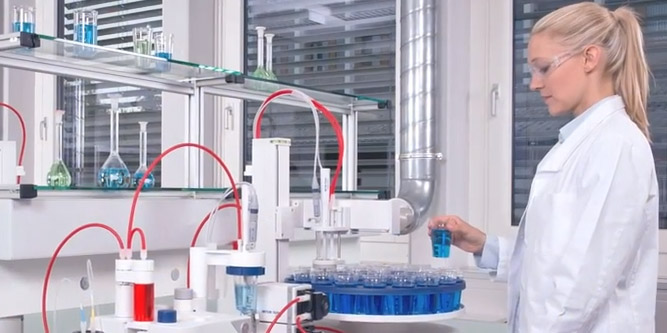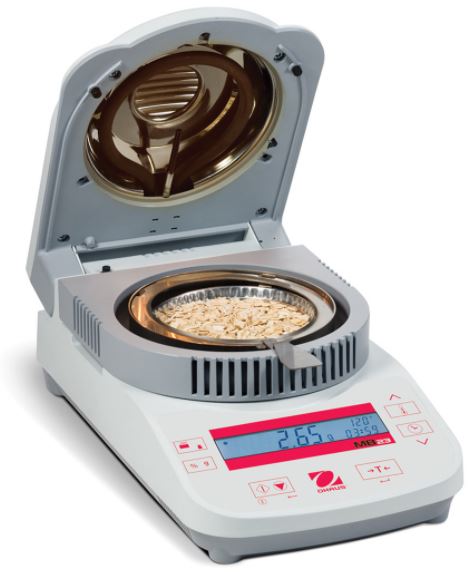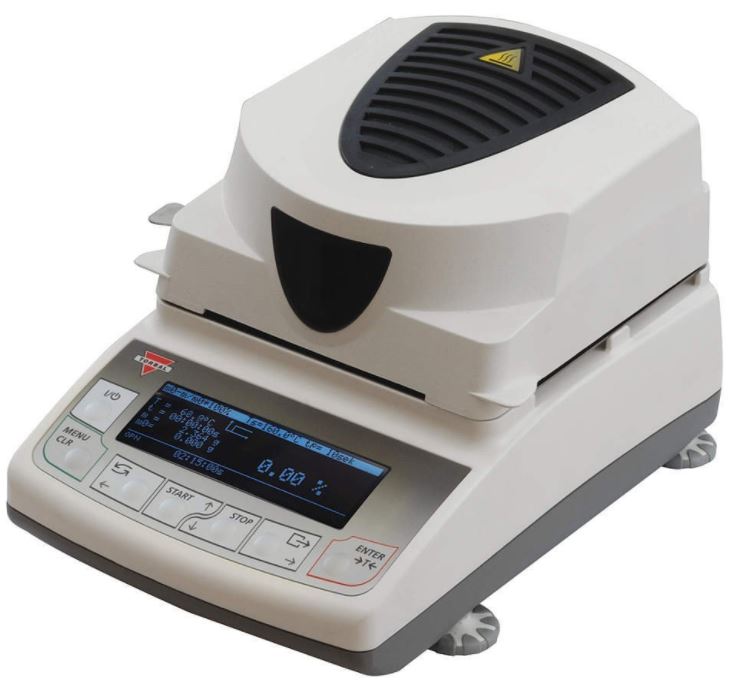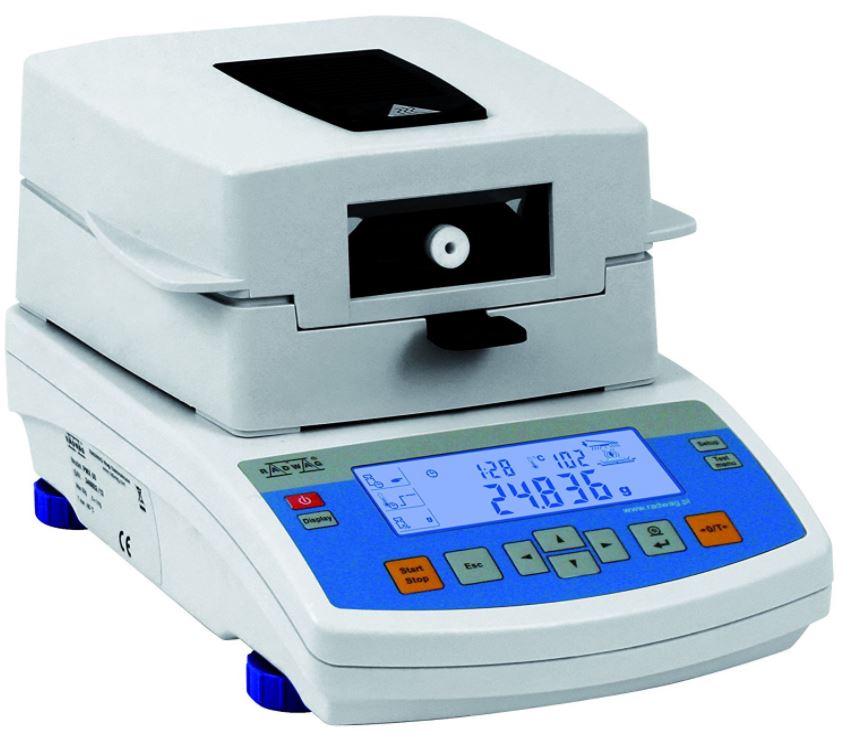Inside of our bodies, the food we eat, and virtually all of the materials that surround you in day-to-day life, you can find moisture. In the right circumstances and quantities, moisture is essential. But you don’t need a river of water to cause a flood of damage. The precise amount of moisture content present in a substance plays a critical part in quality control because having too much or too little moisture content can drastically impact the properties of a material.
Containing even slightly too much or too little moisture, a substance will have a different weight, rate of thermal expansion, conductivity to electrical energy, amalgamation, and even a different range of microbial activity. The viscosity, refractive index, density will also change.
For chemical manufacturing, whether it’s household cleaners, cosmetics, or pharmaceuticals, having the precise quantity of moisture can be necessary to whether or not a product works. For industrial design, the safety, durability, and suitability of a material can radically change with even slight shifts in moisture. And for the food industry, both quality and safety are at play.
In short, being able to accurately measure moisture content is necessary to ensure quality, assess current systems, and adjusting manufacturing to compensate for the results. And the long term result is being able to meet guidelines and regulations, and achieve results that surpass consumer expectations.
Compared to Testing Alternatives
To determine moisture content, a scale has to exploit one of the properties of a substance that changes when moisture is added. For that purpose, the most accurate scientific test you for that purpose is a Karl Fischer titration, which allows you to obtain a direct measurement by either removing the water or interacting with it chemically. However, a Karl Fischer titration requires a drying oven, hours of time, and is particularly vulnerable botched results from user error.
The modern digital alternative to that traditional test is a digital moisture analyzer. These machines make use of the same principles behind Karl Fischer titration, but replace the oven with a heating element under the control of a microprocessor, and directly connected to an analyzer. The result is a sample can be reliably and accurately measured, and a streamlined testing process that involves far less micromanagement and oversight of your instruments. In many cases, the difference in testing time may be only few minutes versus an entire afternoon.
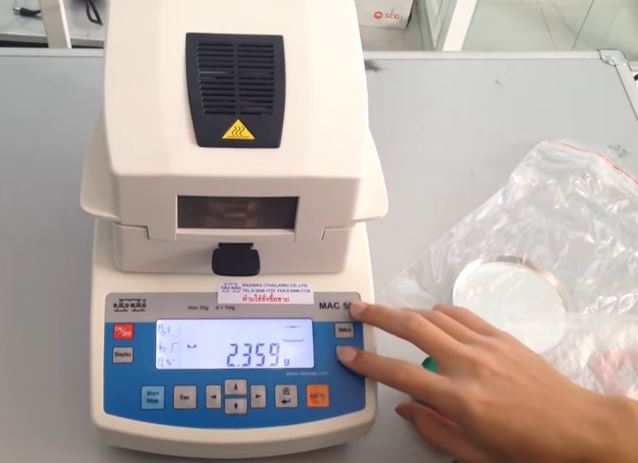
Moisture Balance Solves Problems
Moister analyzers have strengths and weaknesses. Depending on the specific characteristics of the substances you’re measuring, you may find samples vaporize or decompose during heating. That can lead to a loss of mass that will cause an error in your results. With certain extremely temperamental substances, you may be better off using Karl Fischer, or looking for a moisture balance with extremely specific capacities.
But for ordinary materials, a moister analyzer can be an ideal solution. A moisture balance enables far more repeatable, controllable, and easier heating and measurement. Using a balance requires little equipment, and can be run and maintained with next to no cost, especially compared to a Karl Fischer titration heating oven. That makes moisture analyzers not just suitable, but optimal and pragmatic for nearly all types of tests.
Choosing a Moister Analyzer
A general purpose moister analyzer should include the ability to carefully customize the time of your tests, as well as have include a variety premade test template timers. For example, a rapid/fast drying feature can be useful for samples that contain moderate 5-15% moisture content. With a rapid/fast button, you’ll be able to get accurate results within minutes as opposed to hours.
Step drying features are useful for samples that behave differently during analysis. For example, gypsum loses its surface water quickly when placed in a moisture balance, but inside you’ll find water trapped behind crystalline structures that takes far longer to evaporate. Being able to dictate steps and alternating temperatures for drying can be useful for materials like that.
And gentle drying features are useful for samples that can’t take swift rises in temperature, or may otherwise develop some crust that can slow evaporation and impair results. For example, a granular or powered sample will react differently to typical testing than something like paint. And you may need to use slower drying features for those samples.
Finally, a loss-on-drying function can be used to weigh a sample before and after drying, and then automatically determine the percent of moisture that was removed from drying relative to the starting weight of the substance. Depending on what substances you’re looking to analyze, having one or more of these modes preprogrammed can be an essential time saver.
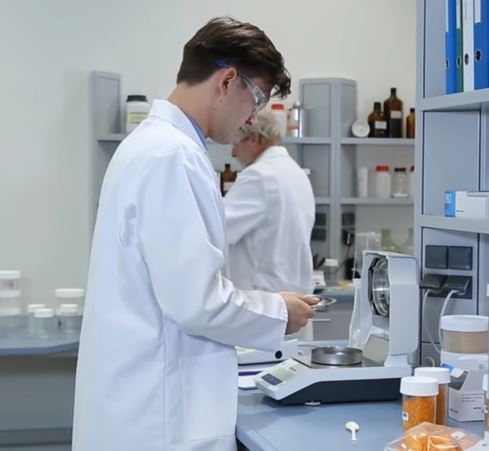
Other Considerations
Depending on the sizes of the samples you’re taking, you may want a larger scale. For most testing purposes, 3-5g is a good sample size. But the maximum capacity for a moisture balance can vary wildly. Additionally, no scale is complete without a tare function. Tare can help discount the weight of the sample plate, filters, or other unrelated materials that you don’t want to be included in your measurements.
Halogen vs Metal Heating
Some moisture balances operate with an infrared heat sources that strike a metal heating element. These types of builds are ideal for tests involving food processing, where glass components can’t be used for either safety or regulation. However, heaters like these have large thermal mass, which take considerably longer to heat up than halogen bulbs. The precision of your control over the heat is also restricted due to the large thermal mass of these devices, which in some circumstances can ultimately affect the reproducibility of your results.
Halogen radiators use tungsten heating elements. They can reach full heat far quicker than infrared could ever hope to achieve, which generally results in samples that are completed faster. The cooling time for halogen radiators matches up with their heating time, so you can switch between various types of samples without lengthy waiting periods. And thanks to the low mass of the halogen radiator, halogen moisture balances allow a finer degrees of control over heating samples, which results in more even heating and reproducible results.
Ohaus MB23 Moisture Balance
If you’re not familiar with then name, Ohaus is a brand that’s specialized in industrial and laboratory grade measuring equipment. Along the broad spectrum of accuracy that people need from a moisture balance, the MB23 is Ohaus’ mid-range scale. It operates with a standard heating profile, which ranges from 50° to 160° Celsius, and increases in increments of 5°. Although it’s not the most advanced moisture balance on the market, it’s more than enough for commercial and non-commercial applications.
Additionally, the MB23 uses a metallic sheathed non-glass infrared heating element that’s well-suited for the food industry. Inside the scale you’ll find a mental pan handler and metal pan support, with a maximum capacity of 110 grams. The accuracy and readability of your measurements extends to 0.1% or 0.01g.
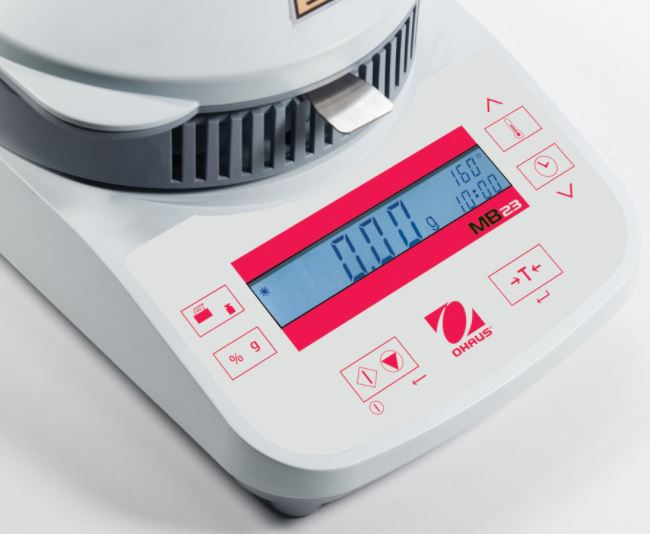
Features and Design
A large backlit display is paired alongside a one-button configuration that makes the MB23 very user friendly. Press and hold the temperature or time button and you’ll be able to establish parameters for drying. From there you just add your sample and the test can begin.
Even an untrained undergraduate student could handle working with the MB23 easily. The internal tray pops out allowing it to be easy to clean, and the fact the trey even exists might end up saving you on a considerable amount of replaceable testing treys. The diameter of the pain is 3.5 inches, and should be enough space for typical 2-3 gram testing sizes.

The MB23 uses a tight 17 x 13 x 28 cm design that makes it suitable for comfortably fitting inside any busy workspace. Alongside the back of the device you’ll find a standard RS232 port, and an in-use cover you can flip over to keep your work from being fiddled with while a test is in progress. Auto-shut off has three criteria you can choose between, timer, automatic, or manual. The timer runs on 1-99 minute increments that can be increased by 30 seconds, which should be enough customization for even the most complicated moisture tests.
Torbal BTS110 Moisture Analyzer
The Torbal BTS110 is a general purpose analyzer built to the highest standards of a general purpose instrument. It offers the same 50°-160° Celsius drying range, and 0.1% or 0.01g readability as the MB23 Ohaus. Where the BTS110 stands out is its inclusion of a 200-watt halogen lamp that’s optimal for controlled drying and high-precision results.
With a moisture balance like the Torbal BTS110, you need to know not just the readability of your results, but the total accuracy of your samples. The accuracy of a sample ranging from 0.02g to 5g is well within 1%. For more sizeable 5g to 50g samples, you can expect remarkable 0.1% accuracy. With larger samples that pass over 50g, you’ll be able to ensure a hyper-accurate 0.01%. Larger samples like that may make use of the maximum drying time of 10 hours, but for everything else, you’ll find most samples can be completed between a few seconds and a few minutes.
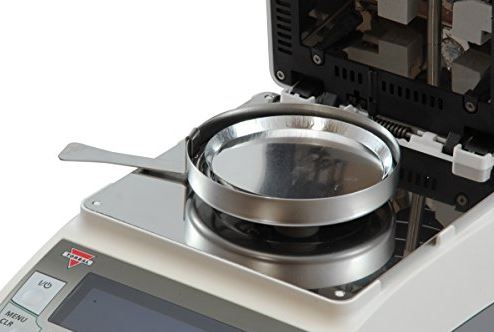
Features and Design
Upon completion of testing, the BTS110 allows you to create a printer record of its completion, listing essentials like drying time, temperature, and of course the moisture content result. This is also where you’ll see notes which you can add to a report with the help of the included PS2 keyboard port. Next to the PS2 port you’ll find a RS232 connection, as well as a USB port for maximum expandability and future-proofing.
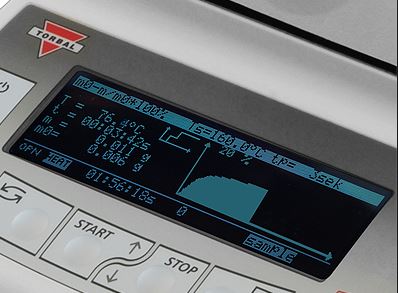
The BTS110 also includes all the most common drying profiles like slow, step, fast, and standard. Naturally, you’ll be able to select each drying profile to maximize the accuracy and efficiency of the specific samples you’re looking at. And to make that a bit easier, the BTS110 has a memory bank that can store 20 parameters for various samples, so you won’t have to re-enter the same parameters again and again to do your testing.
On the downside, the LCD on this balance doesn’t look particularly impressive, but it’s built to support a graph plotting feature to help you map out your samples. Being able to graph various samples is useful for finding the optimal drying parameters for a particular substance, which is great for long-term testing. The 7.2” x 11.4” x 6.5” design sits a little high to save workspace, and includes a 1-year warranty from Torbal.
Nevada Weighing’s Radwag PMC 50
Nevada Weighing is another industrial quality moisture analyzer, but with a small twist. As the name suggests, this moisture content analyzer has a maximum weight capacity of 50 grams. And the PMC 50 provides a flexible halogen heating source with a standard 50° to 160° Celsius testing range, much like the BTS110. But where Radwag really stands out is in its capacity for materials with tiny moisture content. The PMC 50 is specifically designed for things containing less moisture than 1%, like resin, powder, and plastic.
Like other members of this list, the PMC 50 makes use of common drying profiles, including step, rapid, standard, and mild. And it has the same support for incremental weight evaluation that makes it easy to make steady measurements. Once your test is completed, you’ll find moisture intervals as defined as 0.001% readability as well as 0.1 milligram accuracy.
Features and Design
The Radwag PMC 50 supports calibration, but you’ll need an external weight and temperature calibration kit, which you’ll find aren’t included with this moisture balance. The PMC makes use of rimless disposable pans which are 90mm in diameter, and large enough to support the minimum load size of 2 grams.
For more involved and detailed testing, there are also five auto-stop functions you can use to better establish testing parameters, or to keep a test going without having you to micromanage the machine. And as a cherry on top, Nevada Weighing includes a reasonably strong 2-year manufacturer warranty.
Choosing Between 3 Accurate Moisture Analyzers
Your choice in moisture balance depends on the accuracy you need, and the substances you’ll be analyzing. If you’re on a tight budget, the MB23 Ohaus Moisture Balance is great. It uses a non-glass heating element that’s suitable for food industry. Although the accuracy and control over the infrared heating element isn’t particularly impressive, it should be more than enough for people who only demand reasonably accurate results.
If you need a higher degree of accuracy, you’ll want to step up to the Torbal BTS110 Moisture Analyzer. It’s a general purpose instrument that’s has streamlined reporting your data, supports large sample sizes, and is equipped to handle just about any type of testing substance. For textiles, cotton, ovens, and agriculture, you’ll be satisfied with the BTS110.
However, if you’re measuring plastics, resin, or other materials that contain only tiny quantities of moisture content, then you need an instrument that can measure those small amounts. That’s the Nevada Weighing Radwag PMC 50. Its halogen bulb helps provide 0.1 milligram accuracy paired against 0.001% readability, making it the choice for anyone working with extremely dry samples.
Meet Ry, “TechGuru,” a 36-year-old technology enthusiast with a deep passion for tech innovations. With extensive experience, he specializes in gaming hardware and software, and has expertise in gadgets, custom PCs, and audio.
Besides writing about tech and reviewing new products, he enjoys traveling, hiking, and photography. Committed to keeping up with the latest industry trends, he aims to guide readers in making informed tech decisions.

